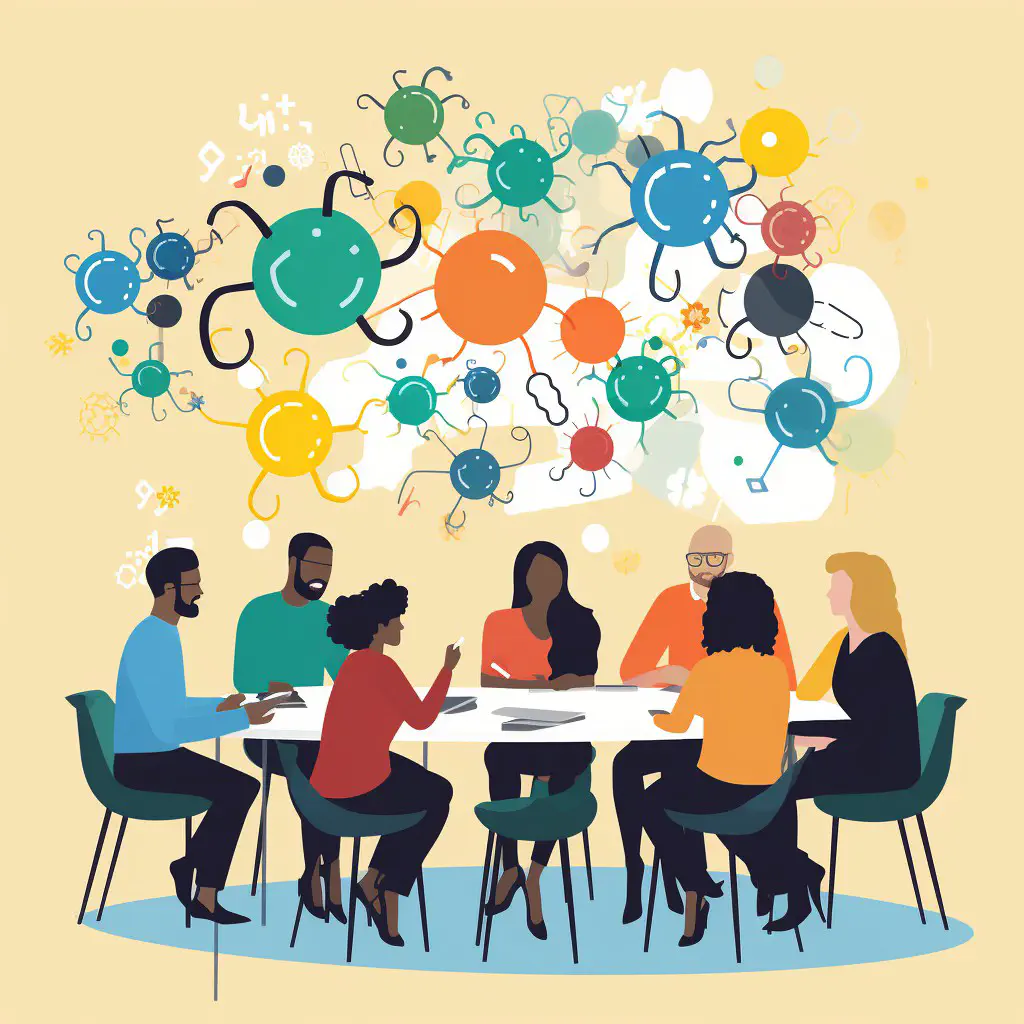
1. What is our ultimate goal as a team?
The success of any collaboration depends on having a clear understanding of the team’s ultimate goal. This goal should be specific, measurable, achievable, relevant, and time-bound. Without a specific goal, team members may be working towards different objectives, causing confusion and a lack of direction. As a team, it is important to clarify and define our ultimate goal so that everyone is aligned and working towards achieving the same outcome. To identify our ultimate goal, we may want to consider the following subtopics:
Vision and Mission
- What is the vision and mission of our team?
- How does our team fit into the larger organization’s vision and mission?
- Are our vision and mission aligned with the needs of our clients/customers/users?
SMART Objectives
- What specific objectives do we need to achieve to reach our ultimate goal?
- Are our objectives SMART (specific, measurable, achievable, relevant, and time-bound)?
- How will we measure progress towards achieving our objectives?
Roles and Responsibilities
- What are the roles and responsibilities of each team member in achieving our ultimate goal?
- Are we making the most of each team member’s unique strengths and skills to achieve our objectives?
- How can we ensure accountability for achieving our objectives?
Having a clear understanding of our ultimate goal, vision, mission, objectives, and roles and responsibilities will enable us to work collaboratively towards a common purpose, and improve our chances of achieving success.
2. What has been our biggest success as a team, and how can we replicate it?
Identifying the success factors
One of the first steps in replicating a past successful effort is identifying what factors contributed to its success. This could include evaluating the processes involved, the skills and expertise involved, the resources used, and any other aspects that made the effort successful.
Documenting the success factors
Once the success factors have been identified, it is important to document them for future reference. This can facilitate knowledge sharing and ensure that these factors are not forgotten.
Sharing the success story
Sharing the success story of the team could help boost the morale of team members and inspire other teams to emulate the success. It could also attract the attention of management and stakeholders, resulting in greater support for the team’s initiatives.
Identifying opportunities for replication
The team could look for opportunities to replicate their past successes in other areas or projects. This could involve identifying similar challenges, problems, or opportunities and applying the success factors that worked in the past.
Continuously improving the success factors
Even after replicating past successes, it is important to continuously improve the success factors. This could involve testing new approaches, incorporating feedback from stakeholders, and experimenting with new resources or technologies. By continuously improving the success factors, the team can stay ahead of the curve and continue to deliver successful outcomes.
3. If we had no limitations, what project or idea would we pursue?
This is an exciting question as it allows team members to be creative and think outside the box. Here are some potential ideas that could emerge:
A revolutionary product or service
Without limitations, the team could create a product or service that is truly innovative and game-changing. This could involve coming up with a new technology or a unique approach to an existing problem. One example might be developing an app that uses artificial intelligence to predict a user’s needs and automatically provide solutions.
A social impact initiative
Another idea could be to pursue an initiative that has a positive impact on society. This could involve partnering with a charity or non-profit organization to solve a pressing issue or create a program that addresses a specific social need. For instance, the team might focus on helping underprivileged children gain access to education or develop a clean water initiative to provide safe drinking water to communities in need.
An artistic or creative endeavor
If the team has members who are creative or artistic, they might choose to explore a project that allows them to express themselves in different ways. This could mean developing a virtual reality art exhibit or creating a short film that showcases the team’s storytelling ability.
A research project
If the team has a strong interest in research or data analysis, they might choose to create a project that delves deep into a particular topic or issue. For example, they might use machine learning to study consumer behavior or use big data to identify trends in a particular industry.
These are just a few examples of the types of projects and ideas that could arise if the team had no limitations. By exploring these ideas together, the team can begin to think creatively and collaboratively, and perhaps even discover new areas of passion and expertise.
4. What are some areas where we could improve our collaboration?
Collaboration is the backbone of any successful team, and identifying areas for improvement is essential for growth. Here are some possible areas where we could improve our collaboration:
Communication
Effective communication is essential for any team to function well. Ensuring that everyone is on the same page and clear about their roles and responsibilities helps to avoid misunderstandings and frustration. Encouraging team members to speak up and share their ideas can also lead to more innovative collaboration.
“Good communication is as stimulating as black coffee, and just as hard to sleep after.” -Anne Morrow Lindbergh
Trust
Trust is a crucial ingredient in any successful collaboration. When team members feel that they can rely on each other, they are more likely to take risks and share their ideas openly. Building trust takes time, but small gestures like showing up on time and following through on commitments can go a long way in establishing a foundation of trust.
“Trust is the glue of life. It’s the most essential ingredient in effective communication. It’s the foundational principle that holds all relationships.” -Stephen Covey
Accountability
Holding oneself and others accountable is key to ensuring that everyone is contributing to the team’s goals. Setting clear expectations, regularly checking in on progress, and taking responsibility for mistakes are all important aspects of accountability. Encouraging team members to hold each other accountable can also build a sense of ownership and investment in the team’s success.
“Accountability breeds response-ability.” -Stephen Covey
Diversity
Diversity of thought, experience, and perspective is a valuable asset in collaborative thinking. Encouraging and welcoming diversity can lead to more creative solutions and a broader understanding of the problems at hand. However, it can also lead to challenges in communication and collaboration. Creating space for different perspectives and ensuring that everyone feels valued and heard can help to overcome these challenges.
“Diversity is not about how we differ. Diversity is about embracing one another’s uniqueness.” -Ola Joseph
By identifying these areas where we could improve our collaboration and working together to address them, we can create a stronger and more effective team.
5. How can our team better serve our clients/customers/users?
In order for any team to be successful, they need to make sure their efforts are aligned with the needs of those they are serving. Whether you work in customer service, software development, or any other field, understanding the needs of your clients, customers, or users is essential for success. Here are some ways your team can better serve your clients/customers/users:
- Listen to their feedback - Encourage your clients/customers/users to share their feedback with your team, and make sure you take the time to listen to them. This feedback can be used to improve current processes and solutions, as well as identify areas where new solutions are needed.
- Understand their pain points - Take the time to understand the challenges that your clients/customers/users face. This can help your team develop solutions that are tailored to their specific needs and address their most pressing concerns.
- Develop user-friendly solutions - Your team should strive to create solutions that are user-friendly and meet the needs of your clients/customers/users. This means prioritizing ease-of-use, accessibility, and intuitiveness.
- Provide exceptional customer service - Whether you work in a customer-facing role or not, providing exceptional customer service should be a top priority for your team. This means being responsive to inquiries and concerns, and going above and beyond to ensure your clients/customers/users are satisfied with your services or products.
- Continuously improve your solutions - Your team should always be looking for ways to improve your solutions and better serve your clients/customers/users. This means regularly soliciting feedback, brainstorming new ideas, and staying up-to-date with industry trends and best practices.
By making an effort to better serve your clients/customers/users, your team can build stronger relationships, improve brand reputation, and ultimately achieve greater success.
6. What is the biggest challenge facing our team, and how can we overcome it?
Asking this question is essential to identify the primary areas of concern or obstacles that might be hindering the team’s progress. By identifying the biggest challenge facing the team, it becomes easier to address and overcome it. Here are some sub-questions that can help tackle this question:
A. What are the current roadblocks that are preventing the team from achieving its goals?
To overcome any challenge, the team needs to identify the underlying cause(s) of that challenge. It might not be evident right away, so it is essential to recognize the subtle symptoms and address them before they become acute problems.
B. What are the different perspectives about the challenges, and can we find a common ground?
When team members work together to solve a problem, they bring different perspectives and ideas to the table. These ideas could be potentially different from the initial direction, and that’s okay. It’s important to find common ground and build on the distinct perspectives to find the best solution.
C. What additional resources, skills, or knowledge do we need to overcome the challenge?
The team should assess what skills or knowledge they may be lacking and look for ways to acquire it. It also includes adding any additional resources, including team members, technology, or tools, needed to address the challenge adequately.
D. What could be the potential risks associated with each solution, and how can we mitigate them?
Any solution comes with potential risks, and the team should assess each solution and weigh the risks against the probability of success. The team should work collaboratively to find ways to mitigate the risks and shore up the chances of success.
E. How can we measure success or progress towards the solution?
The team should define success criteria to measure the progress they make towards a solution. It is important to set deadlines and track progress, while also being flexible enough to pivot their approach if progress does not match expectations.
By asking these sub-questions, the team can identify the underlying issue (roadblocks), find ways to mitigate them (additional resources and risk analysis), and track progress towards a solution (defining success criteria). Working collaboratively and addressing challenges head-on can lead to stronger, more productive collaboration and better outcomes for the team and its stakeholders.
7. What is an idea that you’ve been wanting to share but haven’t had the opportunity to do so?
Asking this question encourages team members to share their ideas and perspectives, which can lead to fresh and innovative collaboration. It’s important to create an environment where team members feel comfortable sharing their ideas without fear of judgment or rejection. Here are some tips to facilitate sharing of ideas:
Tips for sharing ideas
- Encourage listening without interrupting or criticizing
- Create an atmosphere of trust and respect
- Provide enough time for everyone to share their ideas
- Avoid judging ideas during the brainstorming process
- Consider all ideas and look for ways to build upon them
- Don’t be afraid to ask questions or seek clarification
Ideas are the building blocks for innovation and creativity, and it’s essential to encourage every team member to bring their unique perspectives to the table. By asking this question, you can initiate a productive conversation that can lead to a breakthrough idea or solution that otherwise may have been missed. Remember, every idea has value, and sometimes the best ideas come from unexpected sources.
8. Who are some stakeholders outside of our team that we can collaborate with?
Collaboration is not just limited to team members within the organization. There are often external stakeholders who can bring valuable knowledge, expertise, and resources to the table. Here are some potential stakeholders to consider collaborating with:
Industry Experts
Industry experts are individuals or organizations that possess specialized knowledge and experience in a particular area or field. They can provide valuable insights and help your team stay up-to-date with the latest trends and best practices. Collaborating with industry experts can also help your team identify new opportunities and potential partnerships.
Customers/Users
Your team’s ultimate goal is likely to provide value to your customers or users. Therefore, it only makes sense to involve them in the collaborative process. Conducting surveys, holding focus groups, or inviting customers or users to participate in brainstorming sessions can provide invaluable feedback and insights. This collaboration can also lead to the development of more user-friendly and effective products or services.
Community Organizations
Collaborating with community organizations can help your team understand the needs and challenges of the local community. This can open up new opportunities for community engagement and outreach. Additionally, community organizations often have networks and resources that can be leveraged to help achieve your team’s goals.
Academic Institutions
Collaborating with academic institutions can lead to the development of new and innovative ideas. Universities and colleges often have experts in various fields, and collaborating with them can provide access to cutting-edge research, data, and resources. This collaboration can also lead to the development of new products, services, or technologies.
Government Agencies
Collaborating with government agencies can be beneficial for a variety of reasons. For example, if your team is working on a project that requires permits or approvals, collaborating with the relevant government agency can help streamline the process. Additionally, government agencies often have access to resources and data that can be used to inform decision-making and identify new opportunities.
Overall, when considering stakeholders to collaborate with, it’s important to think about what each stakeholder brings to the table and how they can contribute to your team’s goals. By involving a diverse range of stakeholders, your team can access new ideas, resources, and perspectives, leading to more robust and innovative collaborative thinking.
9. What if we approached this challenge from a new angle or perspective?
Challenging assumptions is a critical component of innovative thinking, and this question is designed to encourage just that. Instead of approaching a problem or challenge in the same way that it has always been done, teams can use this question to explore new angles and perspectives.
Changing the Paradigm
Sometimes, the most innovative ideas come from completely changing the paradigm with which we approach a problem. For example, what if we looked at the problem from the perspective of one of our customers? Or, what if we completely flipped the problem on its head and approached it from a different angle altogether?
Reframing the Problem
Another way to approach a problem from a new angle is to reframe it in a different context. For example, what if we looked at the problem through the lens of a different industry? Or, what if we applied a different methodology or framework to the problem than we have in the past?
Brainstorming New Solutions
This question can also be used to encourage teams to brainstorm new solutions altogether. By encouraging individuals to think creatively and explore new avenues, teams can often come up with innovative solutions that they may not have otherwise considered.
Ultimately, by challenging assumptions and encouraging teams to approach challenges from new angles and perspectives, organizations can foster a culture of innovation and collaboration that creates new solutions to old problems.
10. What can we learn from our failures, and how can we use them to grow and improve?
Every team and organization faces failures, mistakes, and setbacks at some point, but what separates successful teams from unsuccessful ones is their ability to learn from these challenges and turn them into opportunities for growth and improvement. Here are some ways your team can use failures as a stepping stone towards innovation and growth:
Understand the root cause of the failure
Before you can learn from a failure, you need to understand the root cause of the problem. It’s important to identify what went wrong, what factors contributed to the failure, and what could have been done differently to prevent it. This will help the team avoid similar mistakes in the future.
Use failure as a learning opportunity
Instead of dwelling on the failure, use it as a chance to learn and grow as a team. Encourage team members to share their thoughts and insights on what went wrong and what could have been done better. Use this discussion as a starting point to identify potential improvements, changes, or new approaches to avoid similar mistakes in the future.
Embrace a growth mindset
A growth mindset is the belief that intelligence, abilities, and skills can be developed over time through hard work, dedication, and persistence. This mindset is key to learning from failures because it helps individuals and teams focus on the process of improvement rather than the end result. Encourage team members to embrace a growth mindset and to view failures as an opportunity to learn and improve.
Celebrate small wins and progress
Learning from failures can take time, and it’s important to celebrate small wins and progress along the way. Encourage team members to acknowledge and recognize small improvements, even if they’re not yet at the point of complete success. Celebrating progress can help keep the team motivated and focused on the path towards growth and innovation.
Use failures to innovate and improve
Failures can also be a catalyst for innovation and change. Encourage team members to think creatively and identify new approaches, ideas, or processes that can help improve the team’s performance in the future. Use the lessons learned from failures to create a culture of experimentation, testing, and continuous improvement.
By embracing failures as a learning opportunity, your team can turn setbacks and challenges into opportunities for growth, innovation, and success.



